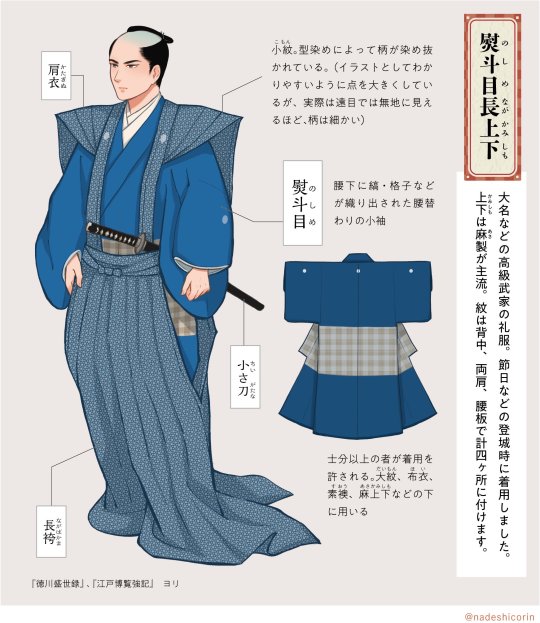#daishô
Explore tagged Tumblr posts
Text
Everyday wear for the warrior class - Nagakamishimo and Hankamishimo
(as worn by samurai of the Edo period - great charts by Nadeshico Rin). You can find more about samurai ranks and their regulated attires under the tag "samurai kimono".
The Nagakamishimo (here with noshime)

長上下 Nagakamishimo was worn by all upper ranked samurai.
肩衣 Kataginu - sleeveless overvest, with startched shoulders. It bore back and shoulder 紋 mon (family crests). It's said to be an evolution of 素襖 Suô attire with detached sleeves. Formal ones were also entirely covered with tiny dyed patterns, the 小紋 komon (clans tended to have their favourite ones, used by all their retainers).
長袴 Nagabakama - hakama pants with long trailing legs. Formal look required it to match the kataginu.
熨斗目 Noshime - kosode (=ancestor of the kimono) with stripes or lattice pattern at waist area. Note the mon family crest on the sleeves and back. Noshime was also worn under more formal sets, like the daimon, suô, hoi, etc.
小さ刀 Chîsagatana - small katana
The Hankamishimo

Also called 継上下 tsugi-gamishimo, 半上下 hankamishimo is the official everyday wear for all Edo period samurai.
Main difference with nagakamishimo are the shorter pants, far more suited to everyday life. Colors and fabrics were not especially regulated.
半袴 Hanbakama - ankle lenght pants, shorter than the more formal nagabakama. Today, it's simply called hakama.
脇差 Wakizashi - short sword worn by samurai, depending on the era is part of the 大小 daishô (sword set with a katana and wakizashi)
紋付小袖 Montsuki-kosode - kosode (=ancestor of the kimono) adorned with family crest
#japan#fashion#fashion history#samurai fashion#nadeshico rin#edo period#samurai#buke#warrior class#edo era#reference#ressources#men kimono#着物#Nagakamishimo#Hankamishimo#kataginu#nagabakama#noshime#Chîsagatana#hanbakama#wakizashi#daishô#Montsuki-kosode#kosode
203 notes
·
View notes
Text
— nohebi

— daishô suguru
— kuguri naoyasu
4 notes
·
View notes
Text
dimanche 6
Aujourdhui , à 8 heures 30, Sreetcar (entre tram et trolley) pour aller à la gare maritime. Ensuite ferry pour l’ile sacrée de Miyajima. Une déception, le fameux torii dans l’eau est en réfection. C’était la porte obligatoire pour les impurs (les pauvres)pour rentrer dans le temple d’Isukushima que nous avons visité et ou nous avons assisté à un mariage. Ensuite nous avons traversé le parc Momijidani pour monter au Mont Misen (535 m d’escaliers). Les marches étaient irrégulières et souvent hautes pour Annie. Une terrasse en haut permet d’admirer le paysage. Nous sommes redescendus du côté du temple Daishô-in et ses 500 statues toutes différentes. Une balade près de l’embarcadère auprès des marchands du temple en passant près de la pagode et nous sommes repartis pour Hiroschima où nous sommes arrivés à la nuit vers 18 heures.dix minutes de pause et départ pour le repas traditionnel d’okonomi, la spécialité locale.
0 notes
Text

Wara ningyô (straw doll) kept at Tono Museum.
Those effigies were once hung on ropes (michikiri) by roadsides and village entrances to ward off evil spirits bringing pestilence (疫病神 yakubyôgami). They were sometimes accessorized, like this one bearing a daishô (katana set) and a fearsome (oni?) face mask.
Waraningyô are also a staple of folk magic alike voodoo dolls, especially those related to eerie uchi no toki mairi ("Ox-hour shrine visits", ie witching hour).
#japan#art & craft#straw doll#wara nyngyô#japanese culture#magic#witchcraft#evil spirits#disease#yakubyôgami#疫病神#uchi no toki mairi#Ox-hour shrine visit#folk culture#ancient belief
422 notes
·
View notes